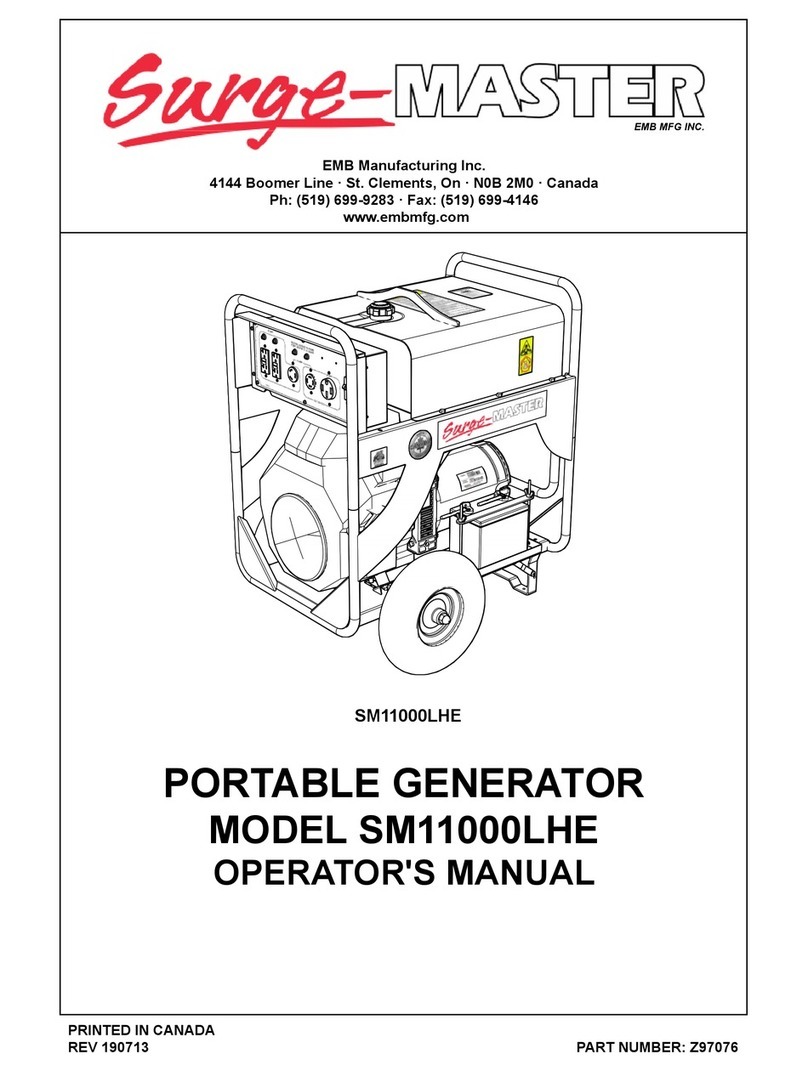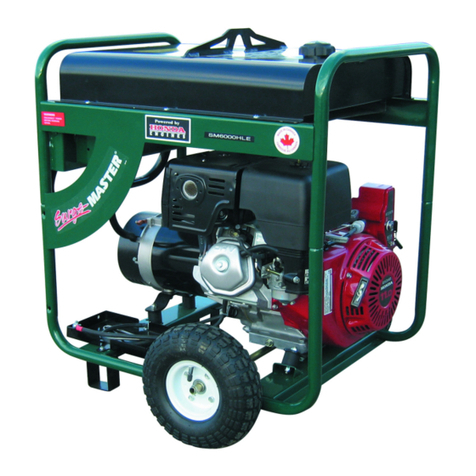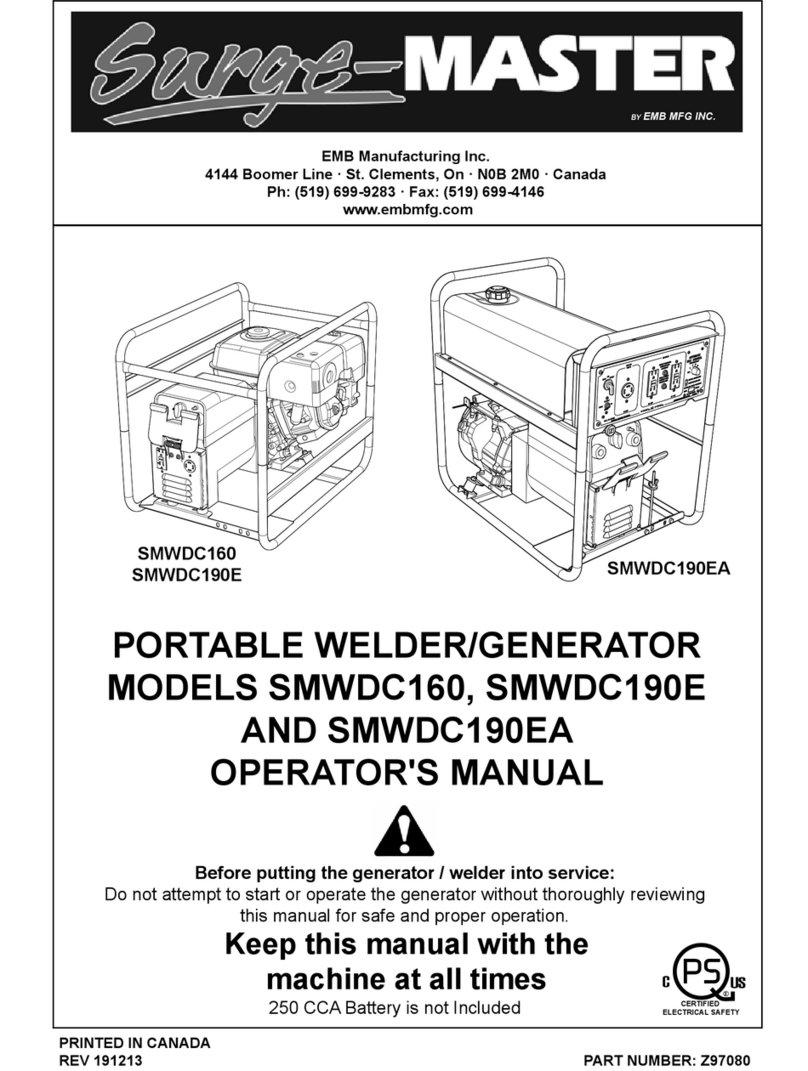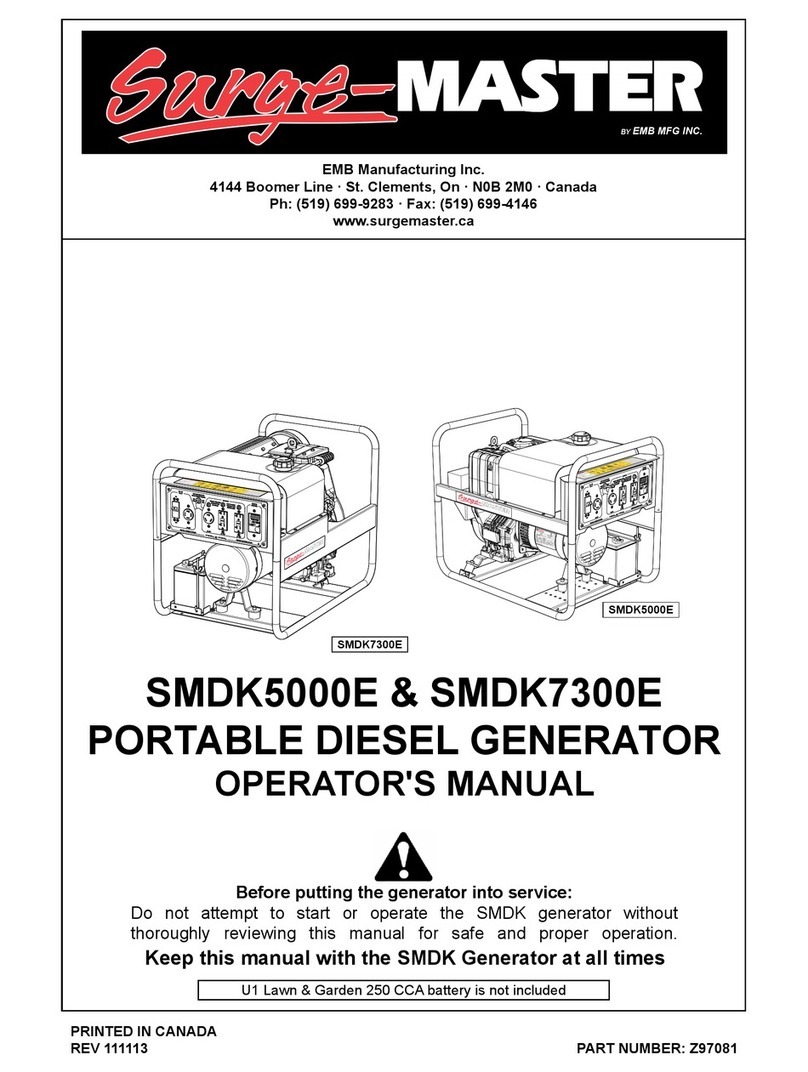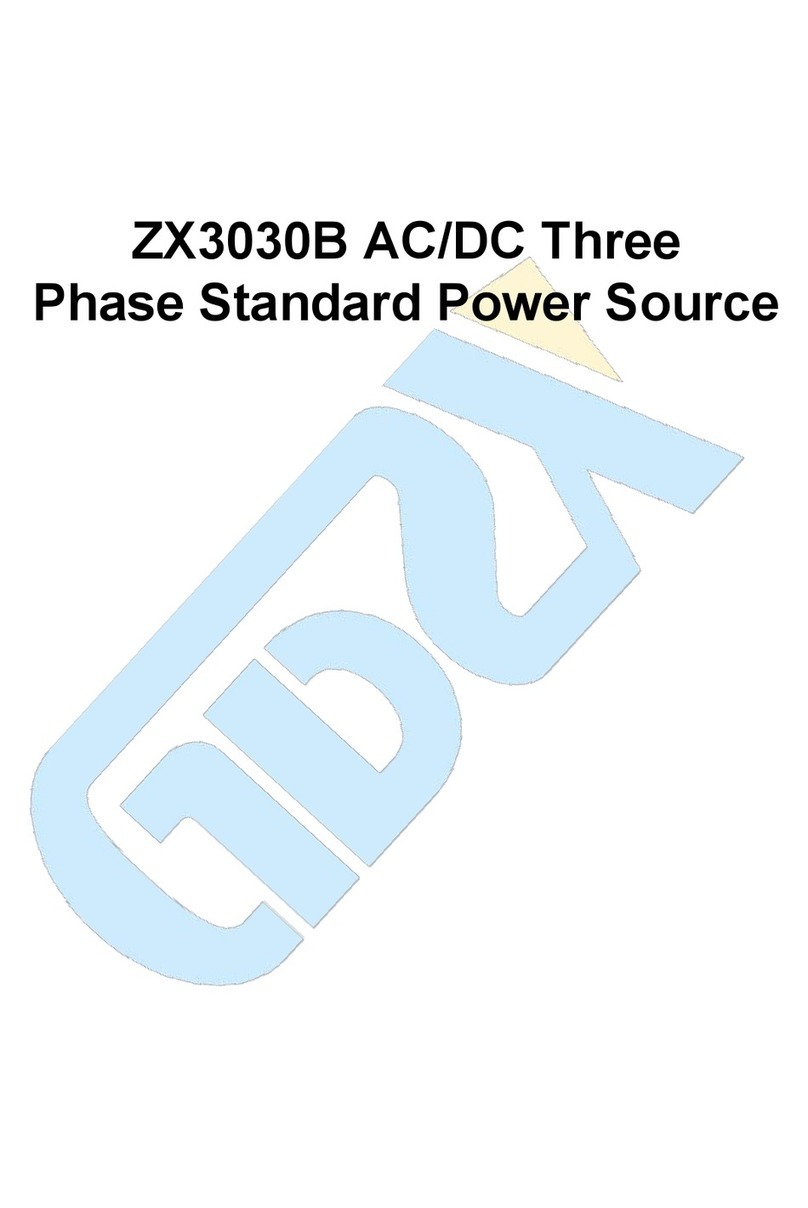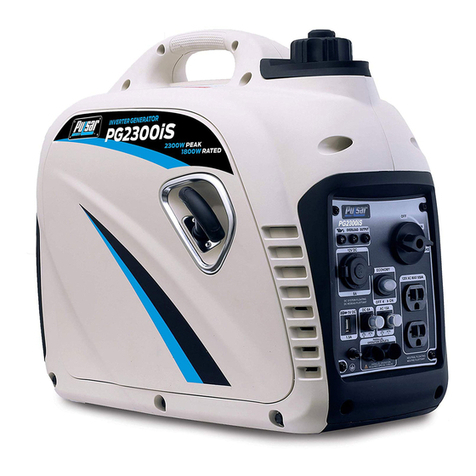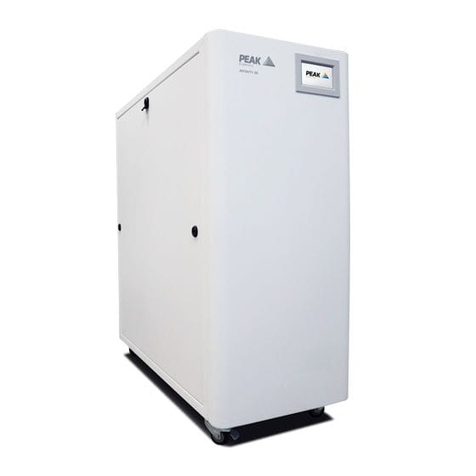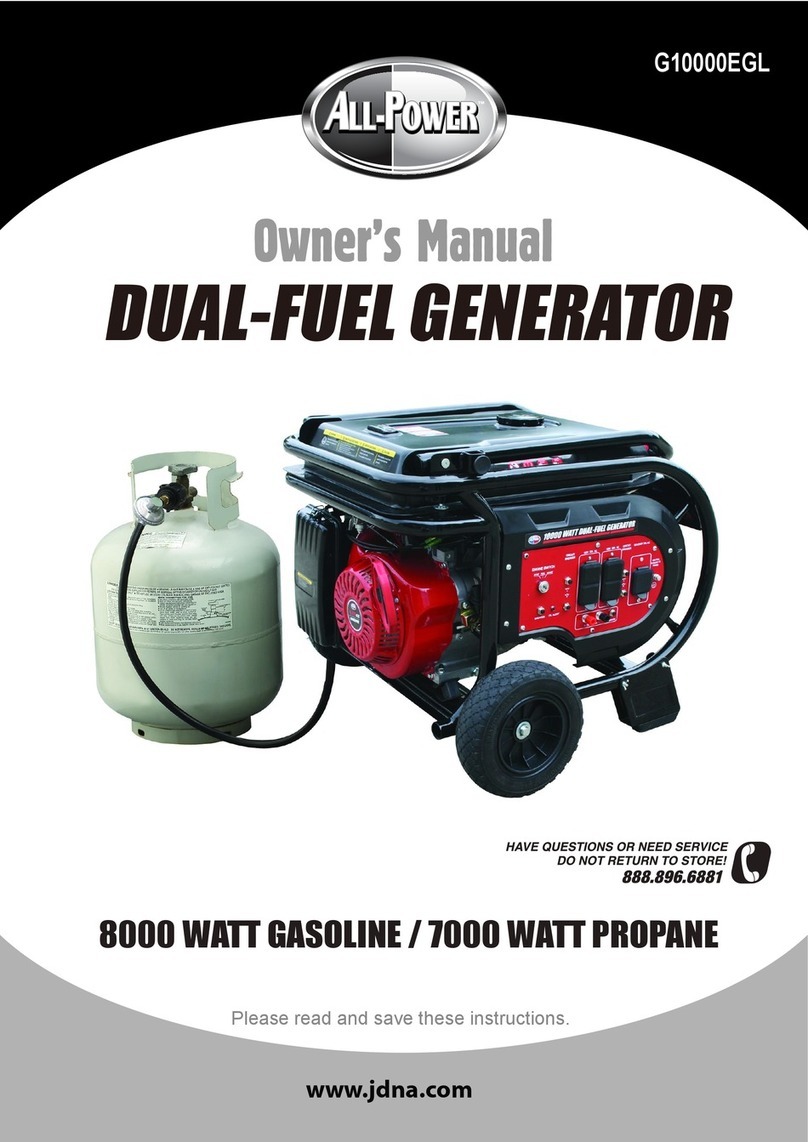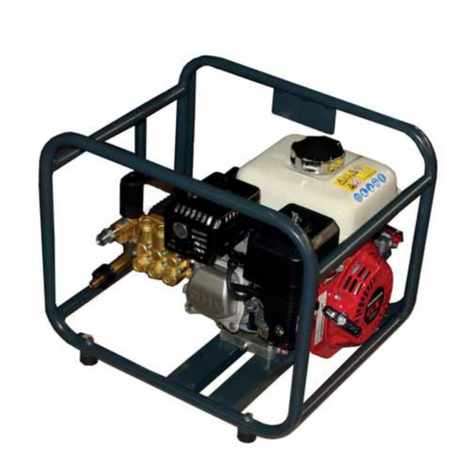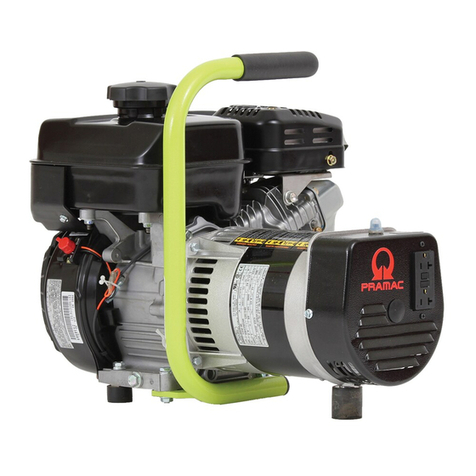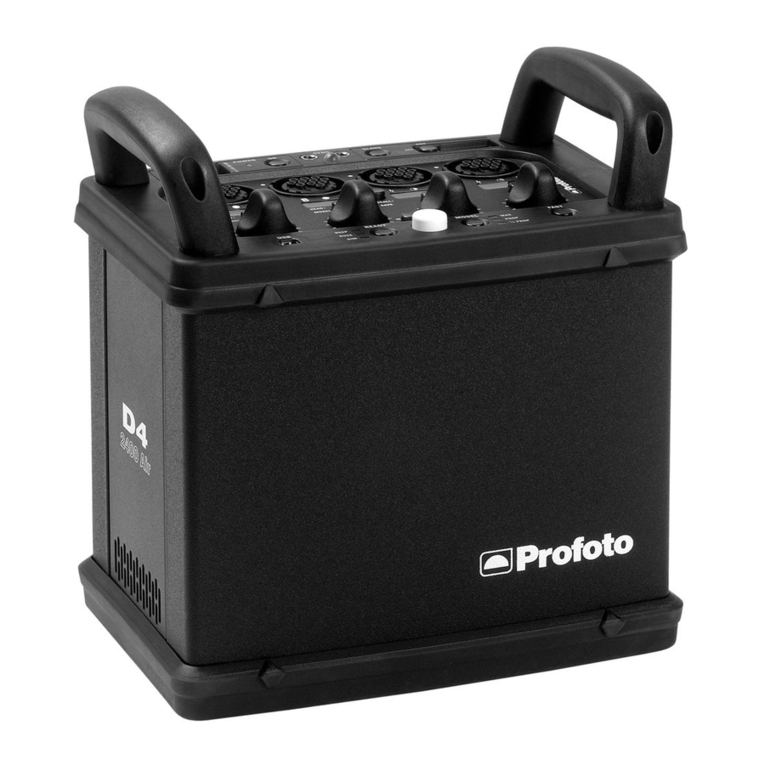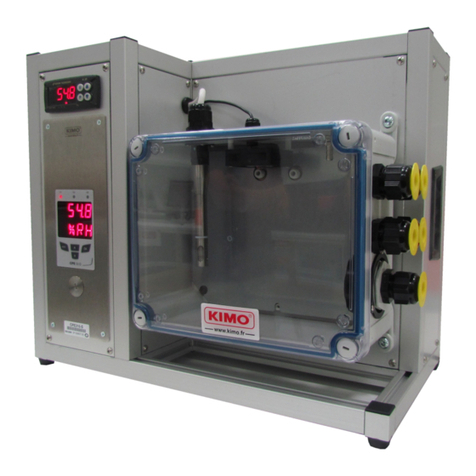SURGEMASTER SM3000SU User manual

SM2500CH
SM3000CH
SM5000CH
PRINTED IN CANADA
REV 0160714 PART NUMBER: Z97037
Before putting the generator into service:
Do not attempt to start or operate the generator without
thoroughly reviewing this manual for safe and proper operation.
Keep this manual with the Generator at all times
EMB Manufacturing Inc.
4144 Boomer Line · St. Clements, On · N0B 2M0 · Canada
Ph: (519) 699-9283 · Fax: (519) 699-4146
www.surgemaster.ca
BY EMB MFG INC.
SM2500CH
SM3000SU SM5000GFI
SM5000CH
SM3000GFI
SM3000CH
PORTABLE GENERATORS
PS
C
US
®
CERTIFIED.
ELECTRICAL SAFETY
SM3000SU
SM3000GFI
SM5000GFI
OPERATOR'S MANUAL

2
TABLE OF CONTENTS
WARRANTY............................................................... 3
SURGEMASTER........................................................ 4
SERIAL NUMBER LOCATION .................................. 5
LABELLING INFORMATION..................................... 5
1 INTRODUCTION........................................... 6
2 SAFETY ........................................................ 7
2.1 SAFETY DO'S & DON'TS' ......................... 8
2.2 EQUIPMENT SAFETY GUIDELINES........ 9
2.3 SAFETY TRAINING................................. 10
2.4 PREPARATION.........................................11
2.5 MAINTENANCE SAFETY........................ 12
2.6 REFUELING SAFETY ............................. 12
2.7 OPERATING SAFETY ............................. 13
2.8 TRANSPORT SAFETY............................ 14
2.9 STORAGE SAFETY................................. 14
2.10 ELECTRICAL SAFETY............................ 14
2.11 GAS MOTOR SAFETY ............................ 15
2.12 SIGN-OFF FORM .................................... 16
3 SAFETY SIGNS.......................................... 17
3.1 HOW TO INSTALL SAFETY SIGNS: ....... 17
3.2 SAFETY SIGN EXPLANATIONS: ............ 17
4 OPERATION & FEATURES ....................... 19
4.1 TO THE NEW OPERATOR OR OWNER 19
4.1.1 SAFE CONDITION ................................. 19
4.2 MACHINE COMPONENTS...................... 20
4.3 MACHINE BREAK-IN .............................. 21
4.4 PREOPERATION CHECKLIST................ 21
4.5 CONTROLS ............................................. 22
4.5.1 ENGINE CONTROLS .............................. 22
4.5.2 ELECTRICAL PANEL............................... 23
SM2500CH & SM300CH ..................... 23
SM3000SU & SM3000GFI .................. 23
SM5000GFI ........................................ 23
SM5000CH .......................................... 23
CIRCUIT BREAKERS:......................... 24
GFCI OUTLETS: ................................. 24
OPERATING HINTS:........................... 24
4.6 ELECTRICAL LOAD ............................... 25
4.6.1 BALANCING LOADS ............................... 25
4.6.2 WATTAGE AND LOAD.........................25
REACTIVE LOAD............................25
RESISTIVE LOAD ...........................25
CONTINUOUS WATTAGE ..............25
MAXIMUM WATTAGE .....................25
4.6.3 CALCULATING LOAD .........................25
4.6.4 WATTAGE CHART...............................26
5 FIELD OPERATION................................27
5.1 PREPARE ............................................27
5.2 START..................................................28
5.2.1 STARTING THE GENERATOR:...........28
5.2.2 STOPPING: .........................................28
5.2.3 EMERGENCY STOPPING: .................28
5.2.4 TERRAIN: ...........................................28
5.2.5 WEATHER: ..........................................28
5.2.6 ELECTRICAL LOADS:.........................28
5.2.7 COMPONENT CONDITION: ...............28
5.2.8 ELECTRICAL HAZARDS:....................28
5.3 RESIDENTIAL......................................29
5.4 MOVING ..............................................29
5.4.1 TRANSPORTING: ...............................29
5.4.2 WHEEL KIT: .........................................29
5.5 STORAGE ...........................................30
5.5.1 PLACING IN STORAGE ......................30
5.5.2 REMOVING FROM STORAGE ...........30
6 SERVICE AND MAINTENANCE ............31
6.1 SERVICE .............................................31
6.1.1 FLUIDS AND LUBRICANTS ................31
6.1.2 FLUIDS AND LUBRICANTS ................31
6.2 MAINTENANCE...................................32
6.2.1 GENERAL MAINTENANCE.................32
6.2.2 ENGINE MAINTENANCE ....................32
6.2.3 ALTERNATOR MAINTENANCE ..........32
7 SPECIFICATIONS ..................................33
7.1 MECHANICAL......................................33
7.2 BOLT TORQUE....................................34
8 TROUBLE SHOOTING...........................35
9 ACCESSORIES ......................................36

3
WARRANTY
WARRANTY
Effective on products retailed on or after September 1, 2011.
Register your product online at www.surgemaster.ca within 30 days of purchase to activate warranty.
This product is warranted to be free of defects in materials and workmanship under normal use and service, for a period of
from the date of purchase, when operated and maintained in accordance with the Operating and Maintenance Instructions
supplied with this unit. Warranty is limited to the repair of the product and/or replacement of parts.
This warranty does not cover the following items:
1) Parts lost or damaged during shipment,
2) Normal maintenance or adjustments
3) Normal replacement of service items.
4) Accessory items / parts not supplied by EMB MFG INC.
5) Damages resulting from:
• misuse, negligence, accident, theft or re
• use of improper or insufcient fuel, uids or lubricants
• use of parts or after market accessories other than genuine EMB MFG INC. parts
• modications, alteration, tampering or improper repair performed by parties other than an authorized servicer
• any device or accessories installed by parties other than an authorized EMB servicer
Engines are covered by the manufacturer of the engine and covered by the warranty period specied by that manufacturer.
Engine warranty must be registered at the engine manufactures website. For service contact your local engine dealer.
Under no circumstances will the manufacturer be liable for any consequential damage or expense of any kind, including loss
of prots. The manufacturer is under no circumstances liable for tow vehicle of any kind. The manufacturer is not liable for
the maintenance of the product.
This warranty is extended only to the original purchaser and is not transferable. Warranty is void if repairs are attempted by
anyone other than an authorized service centre.
If a difculty develops with the product, contact EMB MFG INC. Only our authorized service centres may make repairs to
the product or affect the replacement of defective parts, which will be done at no charge within a reasonable time after the
receipt of the product. Unit or parts shall be returned at the customer’s expense to the authorized service centre. Damage
in transit is not covered by warranty. Include the original purchase receipt with any claim (keep a copy of the receipt
for your les).
The distributor’s liability under warranty is limited to the repair of the product and/or replacement of parts and is given to the
purchaser in lieu of all other remedies including incidental and consequential charges. There are no warranties, expressed
or implied, other than those specied herein.
EMB MFG Inc
4144 Boomer Line, St Clements, ON N0B 2M0 Canada
Phone: 519-699-9283 Fax: 519-699-4146 : attention to Warranty Dept
Email: [email protected]
WARRANTY IS VOID IF NOT REGISTERED
Three (3) Years for Consumer
One (1) Year for Commercial/Rental
rev.091111

4
SurgeMaster
Emergency Power Series: SM2500CH, SM3000CH, SM5000CH
Contractor Ready Series SM3000SU, SM3000GFI, SM5000GFI
DELIVERY INSPECTION REPORT
Pre-Delivery Inspection
Inspect for damage from shipping, immediately contact
the shipping company if damage is found.
Portable Diesel Generator
Check Electrical Connections
Check Function of Generator
Check that Fasteners are Tight
Check Engine Fluid Levels
Review Operating and Safety Instructions
Safety Checks
All Safety Decals Installed
Guards and Shields Installed and Secured
Test GFCI oulets
Review Operating and Safety Instructions
To activate warranty, register your product online at
www.surgemaster.ca
_________________________________________
Customer’s Name
_________________________________________
Contact Name
_________________________________________
Dealer Name
(_________)_______________________________
Phone Number
_________________________________________
Serial Number
__________ /__________ /__________
Delivery Date
I have thoroughly instructed the buyer on the equipment care, adjustments, safe operation and applicable warranty
policy and reviewed the manual.
_________________________________________
Dealer’s Rep. Signature
__________ /__________ /__________
Date
The product manuals have been received by me and I have been thoroughly instructed as to care, adjustments,
safe operation and applicable warranty policy.
_________________________________________
Owner's Signature
__________ /__________ /__________
Date

5
SERIAL NUMBER LOCATION
Always reference the serial number of your SurgeMaster generator when ordering parts or requesting ser-
vice or other information.
The serial number plate is located where indicated. Please mark the numbers in the spaces provided for
easy reference. (Serial label location is the same for ALL models)
SERIAL NUMBER LOCATION
Emergency Power Series or Contractor ReadySeries Portable Gas Generator
Model Number ____________________________________________________
Serial Number ____________________________________________________
safety alert
message
safety label
LABELLING INFORMATION
As you begin to get familiar with your SurgeMaster product, you will notice that there are numerous labels
located on the machine. Here is a brief explanation of what they are for and how to read them.
There are three different types of labelling: safety, informative
and product labels.
Safety Labels are pictorial and always with a yellow back-
ground colour and generally 2 panel. The top panel shows the
safety alert (the potential hazard) and the bottom panel shows
the message (how to avoid the hazard).
Informative Labels are generally pictorial, have a white back-
ground colour and can vary to the number of panels. The label
will illustrate the function of a feature and is accompanied by detailed instructions in the owners manual,
with the label illustrated along side.
Product Labels are associated with the product and carry various messages. (model, serial, etc)
See the section on safety signs for safety label denitions. For a complete illustration of labels and label
locations, download the parts manual for your model product at www.surgemaster.ca.
Serial Location

6
1 INTRODUCTION
SM2500CH
SM3000SU
SM5000CH &
SM5000 GFI
SM3000CH
SM3000 GFI
Congratulations on your choice of the SurgeMaster Generator. This equipment has been designed
and manufactured to meet the needs of a home owner, business operator or industry that needs electric
power during power outage, at a remote location or any time remote power is needed.
Safe, efcient and trouble free operation of your SurgeMaster Generator requires that you and
anyone else who will be using or maintaining the generator, review this SurgeMaster Operators
manual and read and understand the Safety, Operation, Maintenance and Trouble Shooting infor-
mation contained within this Manual.
All SurgeMaster generators are CSA certied and are "neutral bonded to frame" this is a safety feature
that means that the neutral line of the electrical circuit has been bonded to the frame of the generator. The
purpose is to make fulll advantage of the overcurrent protection device to prevent shocks & electrocu-
tion due to a short circuit from a defective cord or device. In effect this will cause the current from a short
circuit to travel back to the generator and activate the breaker, instead of through a person to ground
The
SurgeMaster Emergency Power Series generator
is designed to be a
reliable source of continuous power for the home owner, or
recreational use.
Utilizing robust pull start gas powered engines to provide a steady and
dependable source of power,
in case of power outage,
or when the need
arises. The emergency power series is intended to be connected directly to
the appliance/equipment requiring electrical power. It is not recommended
to connect these generators to a home electrical system without appropriate equipment and a qualied
electrician to make the connections.
The
SurgeMaster Contractor Ready Series generator
are designed with
the contractor in mind. Equipped with GFCI protected outlets, these genera-
tors are a safe and dependable source of continuous power on the job site.
Small and portable,
the pull start gas powered engines produce a steady
and dependable source of power,
for all your power tools.
As well having
the neutral conductor bonded to the frame, Contractor Ready generators
feature GFCI outlet protection, an OSHA requirement when using portable
electrical equipment on job sites.
From home owners, recreational use campers, hunters, snowmobilers, to jobsite contractors, decks,
docks, & fence builders, rugged roll-cage frame to stand-up to jobsite demands, the SurgeMaster
line-up of generators will get you up and running.
Optional Kits: available are the WK210 & WK214 Wheel Kits, which make it a one person job to easily
move your generator into position.
Use the Table of Contents or Index as a guide to locate required information. Keep this manual handy for
frequent reference and to pass on to new operators or owners. Call your Wallenstein dealer or the Distribu-
tor if you need assistance, information or additional copies of the manuals.
OPERATOR ORIENTATION - The directions left, right, front and rear, as mentioned throughout this
manual, are determined when facing the control panel

7
2 SAFETY
SAFETY ALERT SYMBOL
Why is SAFETY important to you?
The Safety Alert symbol identies
important safety messages on the
Wallenstein Generator and in the
manual. When you see this symbol,
be alert to the possibility of personal
injury or death. Follow the instruc-
tions in the safety message.
This Safety Alert symbol means
ATTENTION! BECOME ALERT!
YOUR SAFETY IS INVOLVED!
Accidents Disable and Kill
Accidents Cost
Accidents Can Be Avoided
3 Big Reasons
If you have any questions not answered in this manual or require additional copies or the manual is dam-
aged, please contact your dealer or Wallenstein, 4144 Boomer Line, St. Clements, ON, N0B 2M0. Phone
(519) 699-9283 or Fax (519) 699-4146.
DANGER - Indicates an imminently hazardous
situation that, if not avoided, will
result in death or serious injury. This
signal word is to be limited to the
most extreme situations typically for
machine components which, for func-
tional purposes, cannot be guarded.
WARNING - Indicates a potentially hazardous
situation that, if not avoided, could
result in death or serious injury, and
includes hazards that are exposed
when guards are removed. It may
also be used to alert against unsafe
practices.
CAUTION - Indicates a potentially hazardous
situation that, if not avoided, may
result in minor or moderate injury. It
may also be used to alert against
unsafe practices.
SIGNAL WORDS:
Note the use of the signal words DANGER,
WARNING and CAUTION with the safety
messages. The appropriate signal word for
each message has been selected using the
following guide-lines:

8
SAFETY
YOU are responsible for the SAFE operation and
maintenance of your Wallenstein Portable Gen-
erator. YOU must ensure that you and anyone
else who is going to use, maintain or work around
the generator be familiar with the use and mainte-
nance procedures and related SAFETY informa-
tion contained in this manual. This manual will
take you step-by-step through your working day
and alerts you to all good safety practices that
should be used while using the Generator.
Remember, YOU are the key to safety. Good
safety practices not only protect you but also the
people around you. Make these practices a work-
ing part of your safety program. Be certain that
EVERYONE using this equipment is familiar with
the recommended use and maintenance proce-
dures and follows all the safety precautions. Most
accidents can be prevented. Do not risk injury or
death by ignoring good safety practices.
2.1 SAFETY DO'S & DON'TS'
• DO give operating instructions to operators or
employees before allowing them to operate
the machine, and REVIEW annually thereaf-
ter.
• DO NOT run a generator indoors, a genera-
tor’s exhaust contains toxic carbon monoxide,
which you cannot smell or see. Breathing
carbon monoxide can be lethal.
• DO read and understand ALL
Safety and Operating instruc-
tions in the manual and follow
them. Most accidents can be
avoided. The most important safety device on
this equipment is a SAFE operator.
• DO NOT expect a person who has not read
and understood all use and safety instructions
to operate the machine. An untrained opera-
tor is not qualied and exposes himself and
bystanders to possible serious injury or death.
It is the owners responsibility to the operator
to ensure familiarity and understanding of the
machine.
• DO NOT modify the equipment in any way.
Unauthorized modication may impair the
function and/or safety and could affect the life
of the equipment.
• DO NOT risk injury or death by ignoring good
safety practices.
• DO review safety related items annually with
all personnel who will operating or maintaining
the generator
• DO have a rst-aid kit available
for use should the need arise
and know how to use it.
• DO read and understand all
safety signs located on the
machine before using, maintaining, adjusting
or cleaning the generator
• DO have a re extinguisher suitable
for electrical res available, should
the need arise and know how to use
it.
• DO inspect and secure all guards
before starting.
• DO wear appropriate protective gear. This list
includes but is not limited to:
•Heavy gloves
•Hearing Protec-
tion
•Protective
shoes with slip
resistant
soles
•Protective
glasses, goggles or face shield
• DO prepare before servicing, adjusting, re-
pairing or unplugging:
•stop the machine, disconnect load
•shut off the engine,
•wait for all moving parts to stop
•clear the area of people, especially small
children.
• DO wear suitable ear protec-
tion for prolonged exposure to
excessive noise.
• DO operate on dry level
ground away from combusti-
bles.
• DO NOT touch hot engine parts, mufer, muf-
er cover, engine body, engine oil, etc. during
operation and after the engine has been shut
off. Contact may cause burns.
• DO NOT modify the control panel wiring or
any grounding on the generator
• DO think SAFETY! Work SAFELY!

9
2.2 EQUIPMENT SAFETY GUIDELINES
Safety of the operator and bystanders is one of the main concerns in designing and developing equip-
ment. However, every year many accidents occur which could have been avoided by a few seconds of
thought and a more careful approach to handling equipment. You, the operator, can avoid many acci-
dents by observing the following precautions in this section. To avoid personal injury or death, study the
following precautions and insist those working with you, or for you, follow them.
1. In order to provide a better view, certain
photographs or illustrations in this manual
may show an assembly with a safety shield
removed. However, equipment should never
be used in this condition. Keep all shields in
place. If shield removal becomes necessary
for repairs, replace the shield prior to use.
2. Replace any safety sign or instruction sign
that is not readable or is missing. Location of
such safety signs is indicated in this manual.
3. Never use alcoholic beverages or drugs which
can hinder alertness or coordination while us-
ing this equipment. Consult your doctor about
using this machine while taking prescription
medications.
4. Under no circumstances should young
children be allowed to work with this
equipment. Do not allow persons to use
this until they have read this manual and
have developed a thorough understand-
ing of the safety precautions and of how it
works. Review the safety instructions with all
users annually.
5. This equipment is dangerous to children and
persons unfamiliar with its operation. The
operator should be a responsible, properly
trained and physically able person familiar
with machinery and familiar with this equip-
ment's operations. If the elderly are assisting
with work, their physical limitations need to be
recognized and accommodated.
6. Never exceed the limits of a piece of machin-
ery. If its ability to do a job, or to do so safely,
is in question - DON'T TRY IT.
7. Never run a generator indoors,
a generator’s exhaust contains
toxic carbon monoxide, which
you cannot smell or see. Breath-
ing carbon monoxide can be
lethal.
8. Do not modify the equipment in
any way. Unauthorized modi-
cation may result in serious
injury or death and may impair
the function and life of the equipment.
9. In addition to the design and conguration of
this equipment, including Safety Signs and
Safety Equipment, hazard control and ac-
cident prevention are dependent upon the
awareness, concern, prudence, and proper
training of personnel involved in the operation,
transport, maintenance, and storage of the
machine. Refer also to Safety Messages and
operation instruction in each of the appropri-
ate sections of the engine and machine manu-
als. Pay close attention to the Safety Signs
afxed to the machine.
10. Safe condition involves the following proce-
dure:
•Flip main switch "off" or disconnect all loads
•Shut off the engine.
•Ensure all components have stopped moving.
Safe Condition procedure should be per-
formed before any service, maintenance
work or storage preparation.
Z94216

10
2.3 SAFETY TRAINING
1. Train all new personnel and review instruc-
tions frequently with existing workers. Safety
is a primary concern in the design and manu-
facture of our products. Unfortunately, our ef-
forts to provide safe equipment can be wiped
out by a single careless act of an operator or
bystander.
2. In addition to the design and conguration of
equipment, hazard control and accident pre-
vention are dependent upon the awareness,
concern, prudence and proper training of
personnel involved in the operation, transport,
maintenance and storage of this equipment.
3. It has been said, "The best
safety feature is an informed,
careful operator." We ask
you to be that kind of an
operator. It is the operator's
responsibility to read and understand ALL
Safety and Use instructions in the manual and
to follow these. Accidents can be avoided.
4. Working with unfamiliar equipment can
lead to careless injuries. Read this manual
before assembly or using, to acquaint
yourself with the machine. If this machine
is used by any person other than yourself,
or is loaned or rented, it is the machine
owner's responsibility to make certain that
the operator, prior to using:
• Reads and understands the operator's
manuals.
• Is instructed in safe and proper use of
the equipment.
• Understands and knows how to perform
the "safe condition" procedure:
• Flip main switch "off" or disconnect all
loads
• Shut off the engine.
• Ensure all components have stopped
moving.
5. Know your controls and how to stop the
engine and machine quickly in an emergency.
Read this manual and the one provided with
your engine.
6. Be certain only a properly trained and physi-
cally able person will use the machinery. A
person who has not read and understood all
using and safety instructions is not qualied
to use the machine. An untrained operator
exposes himself and bystanders to possible
serious injury or death. If the elderly are as-
sisting with the work, their physical limitations
need to be recognized and accommodated.

11
4. Clear working area of stones, branches or
hidden obstacles that might be hooked or
snagged, causing injury or damage.
5. Use only in daylight or good articial light.
6. Be sure machine is properly mounted, adjust-
ed and in good operating condition.
7. Ensure that all safety shielding and safety
signs are properly installed and in good condi-
tion.
8. If fuel is on site, store it well away from the
machine and ammable materials.
9. Perform the "PreOperation Checklist" proce-
dure before starting work.
2.4 PREPARATION
1. Never use the engine and machine until the
operators have been adequately trained in the
safe operation of the machine and have read
and completely understand:
• Safety, Operation and Feature sections of
this manual,
• Engine Operator's Manual
• Each of the Safety Messages found on the
safety signs on the engine and machine.
2. Personal protection equipment including:
• safety glasses
• safety shoes
• gloves
• hearing protection
are recommended
during assembly, in-
stallation, operation,
adjustment, maintaining, repairing, removal,
cleaning, or moving the generator. Do not al-
low long hair, loose tting clothing or jewellery
to be around equipment.
3. PROLONGED EXPOSURE TO LOUD NOISE
MAY CAUSE PERMANENT HEARING
LOSS!
Power equipment can often be noisy enough
to cause permanent, partial
hearing loss. We recom-
mend that you wear hear-
ing protection on a full-time
basis. Noise over 85dB on
a long-term basis can cause
severe hearing loss. Noise
over 90db adjacent to the
Operator over a long-term basis may cause
permanent, total hearing loss.
Caution: Hearing lossfrom
loud noise (from tractors,
chain saws, radios, and
other such sources close to the
ear) is cumulative over a lifetime
without hope of natural recovery.

12
9. An appropriate re extin-
guisher (electrical res)
and rst aid kit should be
kept readily accessible
while performing mainte-
nance on this equipment.
10. Inspect and tighten all bolts, nuts and screws
and check that all electrical and fuel connec-
tions are properly secured to ensure genera-
tor is in a safe condition.
11. When completing a maintenance or service
function, make sure all safety shields and de-
vices are installed before placing the genera-
tor in service.
12. When performing maintenance on this equip-
ment always have at least 2 workers present.
Do not work alone in case an emergency
should arise.
13. When cleaning any parts, do not use gasoline
but use regular cleanser.
14. Always use proper tools, that are in good con-
dition. Make sure you understand how to use
them, before performing any service work.
2.6 REFUELING SAFETY
1. Allow the engine to cool if the generator has
been in operation.
2. Refuel only outdoors in a well-ventilated area
with the engine off.
3. Never smoke near fuel, and keep
other ames and sparks away.
4. Do not overll the fuel tank.
5. Always store fuel in an approved
container. Make sure that any
spilled fuel has been wiped up
before starting the engine.
2.5 MAINTENANCE SAFETY
1. Good maintenance is your responsibility. Poor
maintenance is an invitation to trouble.
2. Follow good shop practices.
• Keep service area clean and dry.
• Be sure electrical outlets and tools are
properly grounded.
• Use adequate light for the job at hand.
3. Make sure there is plenty of ventilation. Nev-
er operate the machine or the towing vehicle
in a closed building. The exhaust fumes may
cause asphyxiation.
4. Put the machine in safe condition before
working on this machine:
•Flip main switch "off" or disconnect all loads
•Shut off the engine.
•Ensure all components have stopped moving.
5. Allow the engine to cool before performing
maintenance, engine components and oil
may be hot enough to cause injury.
6. Never work under equipment unless it is
blocked securely.
7. When performing any service or maintenance
work always use personal protection devices
such as
• safety glasses,
• hand protection - gloves
• hearing protectors
• safety shoes
8. Where replacement parts are necessary for
periodic maintenance and servicing, genuine
factory replacement parts must be used to
restore your equipment to original specica-
tions. The manufacturer will not be responsi-
ble for injuries or damages caused by use of
unapproved parts and/or accessories.

13
2.7 OPERATING SAFETY
1. Please remember it is important that you read
and heed the safety signs on the generator.
Clean or replace all safety signs if they can-
not be clearly read and understood. They are
there for your safety, as well as the safety of
others. The safe use of this machine is strictly
up to you, the operator.
2. All things with moving parts are potentially
hazardous. There is no substitute for a cau-
tious, safe-minded operator who recognizes
potential hazards and follows reasonable
safety practices. The manufacturer has
designed this generator to be used with all
its safety equipment properly attached, to
minimize the chance of accidents. Read and
understand operator's manual before starting,
to make sure you have all safety equipment
attached and operational.
3. Close and secure all covers, guards, deec-
tors and shields before starting and operating.
4. Personal protection equipment including hear-
ing protection, safety glasses, safety shoes,
and gloves are recommended during assem-
bly, installation, operation, adjustment, main-
taining, repairing, removal, or moving.
5. Inspect electrical harness, and controller to
ensure they are in good condition before oper-
ating to maintain control.
6. Keep the generator dry. Operate on a dry sur-
face under an open well ventilated, covered
structure.
7. Never run a generator indoors,
a generator’s exhaust contains
toxic carbon monoxide, which
you cannot smell or see. Breath-
ing carbon monoxide can be
lethal.
8. Do not operate near openings to
any building that can be occu-
pied in order to help avoid the
exhaust hazard.
9. Never use alcoholic beverages or drugs which
can hinder alertness or coordination while
operating this equipment. Consult your doc-
tor about operating this machine while taking
prescription medications.
10. Never allow children or unauthorized people
to operate or be around this machine.
11. Plug appliances directly into generator or use
a heavy-duty outdoor-rated extension cord.
Make sure entire extension cord is free of cuts
or tears and the plug has all 3 prongs, espe-
cially a grounding pin.
12. If necessary to connect generator to house
wiring to power appliances, have a qualied
electrician install appropriate equipment. Or,
your utility company may be able to install an
appropriate transfer switch.
13. Keep the working area clean and free of de-
bris to prevent tripping. Operate only on level
ground.
14. Parts of a generator become
very hot during operation and
remain hot for a time after stop-
ping the engine. Be careful not to
touch the mufer while it is hot.
Let the engine cool before stor-
ing the generator indoors.
15. To prevent a possible re, keep
the generator at least 3 feet (1
meter) away from building walls
and other equipment during operation. Do not
place ammable objects close to the engine.
16. NEVER plug the generator into a wall outlet.
This practice, known as backfeeding, can
cause an electrocution risk to utility workers
and others served by the same utility trans-
former.
Z94216
Z94222

14
2.10 ELECTRICAL SAFETY
1. The generator produces
enough electric power to cause
a serious shock or electrocution
if misused.
2. Using a generator or electri-
cal appliance in wet conditions
(rain or snow), or near a pool or
sprinkler system, or when your
hands are wet, could result in
electrocution. Keep the genera-
tor and the immediate area dry.
3. If the generator has been outdoors, unprotect-
ed from the weather, check all of the electri-
cal components on the control panel before
each use. Moisture can cause a short circuit
in electrical components that could result in
electrocution.
4. Do not connect to a building’s electrical sys-
tem unless an transfer / isolation switch has
been installed by a qualied electrician.
5. NEVER tamper with the factory settings of
the engine or engine governor. Engine speed
controls the frequency portion of the electrical
output (60hZ) Personal injury or damage to
the engine or equipment can result if operat-
ing in speed ranges above the maximum or
below the minimum allowable.
2.9 STORAGE SAFETY
1. Store the unit in a well vented area away from
human activity.
2. If possible, store in a dry area, avoid storage
areas with high humidity, because that pro-
motes rust and corrosion.
3. Avoid any area where power tools are oper-
ated or spark-producing electric motors.
4. Do not allow children to play on or around the
stored machine.
5. Place the generator on a level surface. Tilt-
ing or laying it on its side can cause fuel or
oil leakage. Support the frame with planks if
required.
6. Allow the engine / exhaust to cool. A hot
engine and exhaust system can ignite or melt
some materials.
7. With the engine and exhaust system cool,
cover the generator to keep out dust.
8. Do not use a nonporus sheet as a dust cover.
A nonporous cover will trap moisture around
the generator, promoting rust and corrosion.
Z94221
2.8 TRANSPORT SAFETY
1. Comply with Provincial / state and local laws
governing safety and transporting of machin-
ery on public roads.
2. Do not exceed a safe travel speed. Slow
down for rough terrain and cornering.
3. Do not transport or move the generator with
the engine running.
4. Inspect all access panels and guards to en-
sure they are secured.
5. If the generator has been running, allow the
engine to cool for at least 15 minutes before
loading the generator on the transport vehicle.
A hot engine and exhaust system can burn
you and may ignite some materials.
6. Ensure the fuel tank cap is on tight and keep
the generator level when transporting to re-
duce the possibility of fuel leakage.
7. Move the fuel valve lever to the OFF position.
8. When using ropes or tie-down straps to
secure the generator for transportation, be
sure to only use the frame bars as attachment
points. Do not fasten ropes or straps to any
portions of the generator body.
9. Do not drink and drive.
10. Just before transport, perform a circle check
to ensure everything is safe and secure.

15
2.11 GAS MOTOR SAFETY
BEFORE STARTING ENGINE, READ
AND UNDERSTAND THE OPERATING
AND MAINTENANCE INSTRUCTIONS
THAT CAME WITH YOUR ENGINE.
WARNING: DO NOT
1. DO NOT run engine in an enclosed area. Ex-
haust gases contain carbon monoxide, an odour-
less and deadly poison.
2. DO NOT place hands or feet near moving or
rotating parts.
3. DO NOT store, spill, or use gasoline near an
open ame, or devices such as a stove, furnace,
or water heater which use a pilot light or devices
which can create a spark.
4. DO NOT refuel indoors where area is not well
ventilated. Outdoor refuelling is preferred.
5. DO NOT refuel while engine is running. Allow
engine to cool for 5 minutes before refuelling.
Store fuel in approved safety containers.
6. DO NOT remove fuel tank cap while engine is
running.
7. DO NOT operate engine if gasoline is spilled.
Move machine away from the spill and avoid cre-
ating any ignition until gasoline has evaporated.
8. DO NOT smoke while lling fuel tank.
9. DO NOT choke carburetor to stop engine. When-
ever possible, gradually reduce engine speed
before stopping.
10. DO NOT run engine above rated speeds. This
may result in injury.
11. DO NOT tamper with governor springs, gover-
nor links or other parts which may increase the
governed speed.
12. DO NOT tamper with the engine speed selected
by the original equipment manufacturer.
13. DO NOT check for spark with spark plug or spark
plug wire removed.
14. DO NOT crank engine with spark plug removed.
If engine is ooded, crank until engine starts.
15. DO NOT strike ywheel with a hard object or
metal tool as this may cause ywheel to shatter
in operation. Use proper tools to service engine.
16. DO NOT operate engine without a mufer. Inspect
periodically and replace, if necessary. If engine
is equipped with a mufer deector, inspect pe-
riodically and replace, if necessary with correct
deector.
17. DO NOT operate engine with an accumulation of
grass, leaves, dirt or other combustible materials
in the mufer area.
18. DO NOT use this engine on any forest covered,
brush covered, or grass covered unimproved land
unless a spark arrester is installed on the mufer.
The arrester must be maintained in effective work-
ing order by the operator. In the state of California
the above is required by law (Section 4442 of the
California Public Resources Code). Other states
may have similar laws. Federal laws apply on
federal land.
19. DO NOT touch hot mufer, cylinder or ns be-
cause contact may cause burns.
20. DO NOT run engine with air cleaner or air cleaner
cover removed.
WARNING: DO
1. ALWAYS DO remove the wire from the spark plug
when servicing the engine or equipment to pre-
vent accidental starting. Disconnect the negative
wire from the battery terminal if equipped wit a 12
volt starting system.
2. DO keep cylinder ns and governor parts free of
grass and other debris which can affect engine
speed.
3. DO examine mufer periodically to be sure it is
functioning effectively. A worn or leaking mufer
should be repaired or replaced as necessary.
4. DO use fresh gasoline. Stale fuel can gum car-
buretor and cause leakage.
5. DO check fuel lines and ttings frequently for
cracks or leaks. Replace if necessary.

16
2.12 SIGN-OFF FORM
Wallenstein follows the general Safety Standards specied by the American Society of Agricultural and
Biological Engineers (ASABE) and the Occupational Safety and Health Administration (OSHA). Any-
one who will be using and/or maintaining the Portable Generator must read and clearly understand ALL
Safety, Usage and Maintenance information presented in this manual.
Do not use or allow anyone else to use this generator until such information has been reviewed. Annually
review this information before the season start-up.
Make these periodic reviews of SAFETY and OPERATION a standard practice for all of your equipment.
We feel that an untrained operator is unqualied to use this machine.
A sign-off sheet is provided for your record keeping to show that all personnel who will be working with the
equipment have read and understand the information in the Operator’s Manual and have been instructed
in the operation of the equipment.
EMPLOYEES SIGNATURE EMPLOYERS SIGNATURE
SIGN-OFF FORM
DATE

17
3 SAFETY SIGNS
1. Keep safety signs clean and legible at all times,
2. Replace safety signs that are missing or have become illegible.
3. Replaced parts that displayed a safety sign should also display the current sign.
4. Safety signs in Section 3 each have a part number displayed with it. Use this part number when
ordering replacement parts.
5. Safety signs are available from your authorized Distributor or Dealer Parts Department or the factory.
Z94222
Z94221
Caution: Never run a gen-
erator indoors, a genera-
tor’s exhaust contains toxic
carbon monoxide, which
you cannot smell or see.
Breathing carbon monoxide
can be lethal.
Caution: Parts of a generator become
very hot during operation and remain
hot for a time after stopping the engine.
Be careful not to touch the mufer while
it is hot. Let the engine cool before stor-
ing the generator indoors.
Caution: A generator produces enough
electrical power to cause serious shock
or electrocution. Using a generator in
wet conditions such as in rain or snow, ,
or with wet hands could result in elec-
trocution. Keep the generator dry.
Caution: do not refuel the machine
while smoking or when near open
ame or sparks. Fuel is highly amma-
ble, handle with care.
Caution: read and understand ALL
safety and operating instructions in
the manual, read and understand ALL
safety labels located on the machine.
The most important safety device on
this equipment is an informed SAFE
operator.
3.2 SAFETY SIGN EXPLANATIONS:
3.1 HOW TO INSTALL SAFETY SIGNS:
• Be sure that the installation area is clean and dry.
• Be sure temperature is above 50°F (10°C).
• Determine exact position before you remove the backing paper.
• Remove the smallest portion of the split backing paper.
• Align the sign over the specied area and carefully press the small portion with the exposed sticky
backing in place.
• Slowly peel back the remaining paper and carefully smooth the remaining portion of the sign in place.
• Small air pockets can be pierced with a pin and smoothed out using the piece of sign backing paper.
NEVER use inside a home or
garage, EVEN IF doors and
windows are open.
N'employerJAMAIS dans la
maisonoudans dessecteurs
partiellement inclustelsque des
garages,MÊMESIles portes et
lesfenetressoientouvertes.
Only use OUTSIDE and far
away from windows, doors,
and vents.
Employer seulemer DEHORS
et loin de fenêtres, desporte
et des ventilateurs.
DANGER!
Using a generator indoors CAN KILL YOU IN MINUTES. Generator
Exhaust contains carbon monoxide. This is a poison you cannot see
or smell.
L'utilisation d'un générateur àl'intérieur PEUT VOUS FAIRE MOURIR
EN MINUTES. L'échappement contient le monoxyde de carbone,
Ceci est un toxiqueque vous ne pouveznivoirni sentir.
Z94225
NEUTRAL BONDED TO FRAME
NEUTRE RACCORDÉ AU BÂTI
Z94170
Note: this is a
safety feature and
indicates that the
neutral line of the electrical circuit has been
bonded to the frame of the generator.

18
REMEMBER - If safety signs have been damaged, removed, become illegible or parts replaced without
safety signs, new signs must be applied. New safety signs are available from your authorized dealer.
3 SAFETY SIGN LOCATIONS
The types of safety signs and locations on the equipment are shown in the illustrations that follow. Good
safety requires that you familiarize yourself with the various safety signs, the type of warning and the
area, or particular function related to that area, that requires your SAFETY AWARENESS.
• Think SAFETY! Work SAFELY!
Z94901
94221
94222
NEVER use inside a home or
garage, EVEN IF doors and
windows are open.
N'employerJAMAIS dans la
maison ou dans des secteurs
partiellement inclus tels que des
garages, MÊME SI les portes et
les fenetres soient ouvertes.
Only use OUTSIDE and far
away from windows, doors,
and vents.
Employer seulemer DEHORS
et loin de fenêtres, des porte
et des ventilateurs.
DANGER!
Using a generator indoors CAN KILL YOU IN MINUTES. Generator
Exhaust contains carbon monoxide. This is a poison you cannot see
or smell.
L'utilisation d'un générateur à l'intérieur PEUT VOUS FAIRE MOURIR
EN MINUTES. L'échappement contient le monoxyde de carbone,
Ceci est un toxique que vous ne pouvez ni voir ni sentir.
94225
NEUTRAL BONDED TO FRAME
NEUTRE RACCORDÉ AU BÂTI
GENERATOR MUST BE USED IN SHELTERED OUTDOOR USE ONLY
CETTE GÉNÉRATRICE DOIT ÊTRE UTILISÉ SOUS UN
ABRI EXTÉRIEUR AU SEC SEULEMENT
Z94901

19
4 OPERATION & FEATURES
The SurgeMaster Portable Generators are de-
signed to provide portable electrical power to
equipment that is not connected to the electrical
grid system.
It is the responsibility of the owner or opera-
tor to read this manual and to train all other
operators before they start working with the
machine. Follow all safety instructions exact-
ly. Safety is everyone's business. By follow-
ing recommended procedures, a safe working
environment is provided for the operator,
bystanders and the area around the work site.
Untrained operators are not qualied to use
the machine.
Many features incorporated into this machine are
the result of suggestions made by customers like
you. Read this manual carefully to learn how
to use the Generator safely and how to set it to
provide maximum eld efciency. By following
the using instructions in conjunction with a good
maintenance program, your Portable Generator
will provide many years of trouble-free service.
4.1.1 SAFE CONDITION
Ensure all operators understand how to put
the machine in safe condition before working
with this machine,
•Flip main switch "off" or disconnect all loads
•Shut off the engine.
•Ensure all components have stopped moving.
4.1 TO THE NEW OPERATOR OR OWNER
OPERATING SAFETY
• Read and understand operator's manual before
starting. Review safety instructions annually.
• Stop and disable engine, and wait for all mov-
ing parts to stop before servicing, adjusting or
repairing.
• To prevent electrical shocks, do not operate
this generator in the rain or with wet hands.
Generator should be kept dry and not operated
on wet or damp surfaces.
• Close and secure all guards, deectors and
shields before starting and operating.
• Do not connect the generator to a commercial
power line.
• Do not operate with damaged or defective ex-
tension cords, or power cords. Protect the cord
from getting pinched or crushed if it passes
through a window or doorway.
• Use properly rated, grounded 3-prong exten-
sion cords, tools, and appliances.
• Do not operate this generator indoors, or
in areas with poor ventilation. The exhaust
fumes contain carbon monoxide, a poisonous,
odourless, invisible gas. Prolonged exposure
can lead to unconsciousness and death.
• Do not refuel the engine while it is in opera-
tion or still hot. Do not refuel the engine near
open ames, pilot lights or sparking electrical
devices (e.g. power tools, welders or grinders).
• To prevent a possible re, keep the generator
at least 1 meter (3 feet) away from building
walls and other equipment during operation.
• Do not place ammable objects close to the
engine.
• The engine should be refuelled in a well-lit,
adequately vented area. Avoid fuel spillage.
• Never allow children or unauthorized people
to operate or be around this machine.
• Keep the working area clean and free of
debris to prevent tripping. Operate only on
level ground.
• Do not cover the generator while in operation.
Overheating can result in damaged equipment.
• For storage, do not cover the generator until
it has cooled down completely.
• The ambient temperature should not exceed
100° F/40° C.

20
4.2 MACHINE COMPONENTS
SurgeMaster Portable Generators consists of sev-
eral models of generators. Although slightly dif-
ferent for each model, controls and power outlets
are mounted in similar locations for convenient
access and operation.
The unit is designed to provide electrical power for
work (Contractor Ready series) or home (Emer-
gency Power series). Each outlet is designed with
a circuit breaker to protect against overload. For
protection against electrical shocks from short cir-
cuits, the machine is neutral bonded to the frame.
The entire assembly is mounted within the frame
for added protection and convenient access.
Alternator
Outlets
Circuit
Breaker
Engine
see "Controls" sec-
tion and engine own-
ers manual for more
engine information
Frame
Series Model
Engine
cc
Alternator
kVA
Continuous
wattage
Maximum
wattage
SM2500CH 160cc 2.9 kVA 2100 2500
SM3000CH 160cc 2.9 kVA 2700 3000
SM5000CH 270cc 4.9 kVA 4500 5000
SM3000SU 169cc 2.9 kVA 2500 3000
SM3000GFI 160cc 2.9 kVA 2700 3000
SM5000GFI 270cc 4.9 kVA 4500 5000
Note:
All SurgeMaster generators are CSA certied and have the safety feature
of the neutral conductor bonded to the frame, an OSHA requirement when
using portable electrical equipment on job sites.
This manual suits for next models
5
Table of contents
Other SURGEMASTER Portable Generator manuals
Popular Portable Generator manuals by other brands
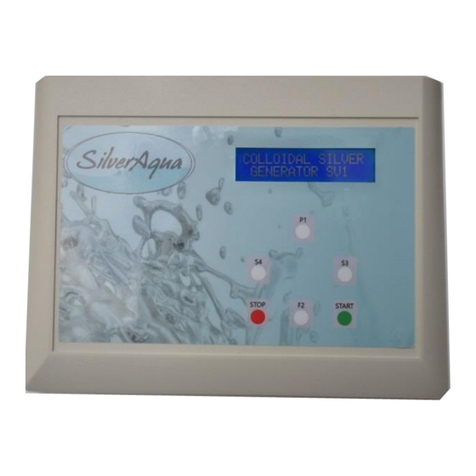
SilverAqua
SilverAqua SV1 Use and maintenance manual
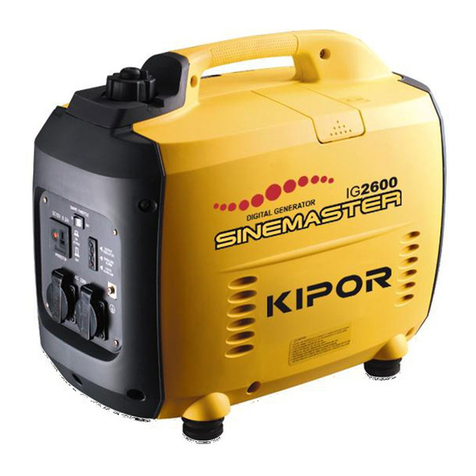
Kipor
Kipor Sinamaster I G2600 Operation manual
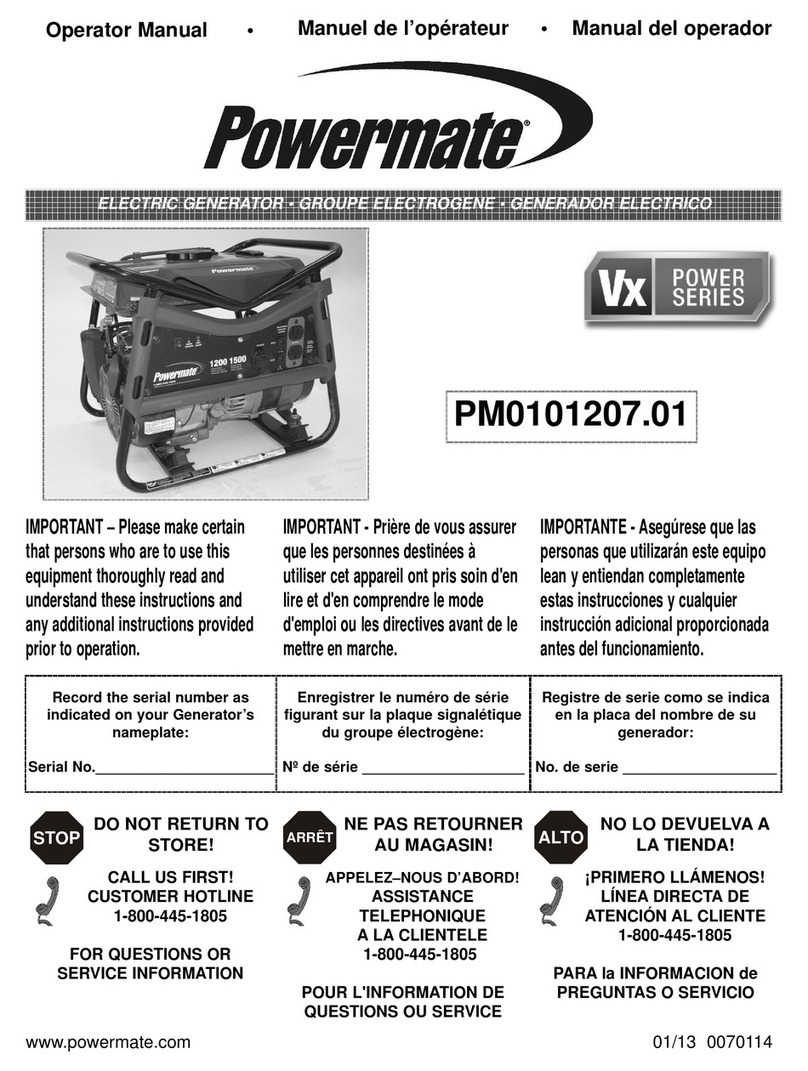
Powermate
Powermate PM0101207.01 Operator's manual

Golden engineering
Golden engineering X-RAY XRS4RA Operator's manual
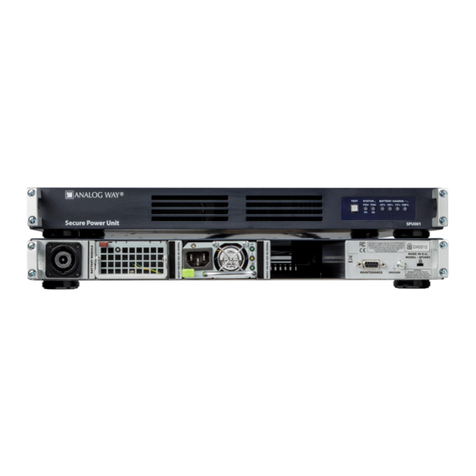
Analog way
Analog way Secure Power Unit quick start guide
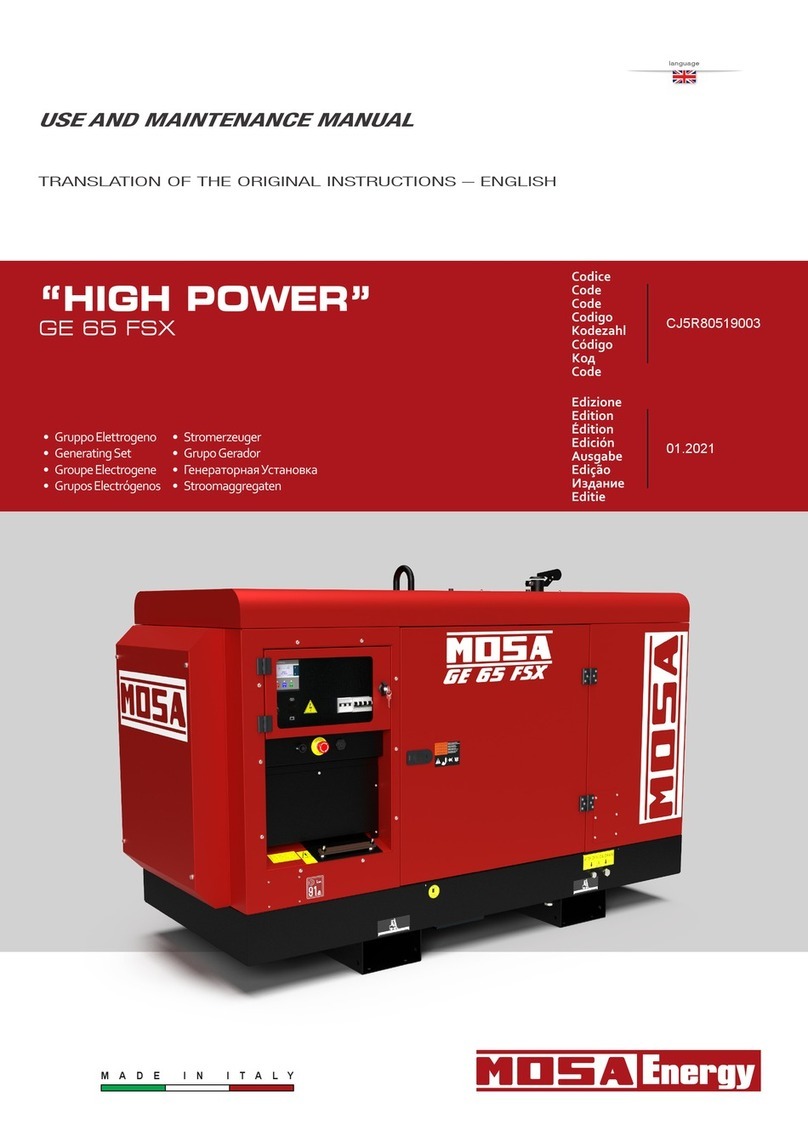
Mosa
Mosa HIGH POWER Use and maintenance manual

